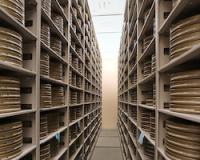
Published by UCLA Newsroom | December 4, 2019
The UCLA Film & Television Archive, the second-largest repository of motion pictures and broadcast programming in the U.S., is now part of the UCLA Library.
The Archive, which had operated under the auspices of the UCLA School of Theater, Film and Television, will now be more closely aligned with the UCLA Library’s world-class archival and research collections; the move positions the Archive’s holdings to be better integrated in instruction and research at UCLA, and it will expand access to the Archive through the Library’s robust digital platforms.
“The UCLA Library and the Film & Television Archive are longtime partners with a shared vision of preserving unique, historical materials and making them available to the UCLA and wider academic communities,” said Ginny Steel, UCLA’s Norman and Armena Powell University Librarian. “Having the Archive as part of the UCLA Library strengthens the collective impact of print, digital and audiovisual resources on teaching and learning.”
The Archive’s administrative offices, preservation labs and collection storage vaults will remain at the Packard Humanities Institute's Stoa in Santa Clarita, California, while the Archive Research and Study Center, located in Powell Library on the UCLA campus, will continue to serve as a campus access point to the Archive’s collections.

Materials at the Library and Film & Television Archive already significantly complement one another, including both units’ shared commitment to documenting diverse communities:
-
UCLA Library Special Collections holds photographs, correspondence, audio recordings and other materials from the first female member of the Directors Guild of America in the Dorothy Arzner Papers, while the Archive has restored several of her films, including The Wild Party and Working Girls.
-
The Archive preserved and has made accessible online all 21 seasons of In the Life, the first nationally broadcast newsmagazine series advocating LGBTQ visibility and equality. Enhancing the episodes are synopses and transcripts, story research and publicity files in Library Special Collections.
-
The Archive’s newsreel and documentary film footage of Japanese Americans’ incarceration during World War II combined with Library Special Collections’ Manzanar War Relocation Center records, its Japanese American Research Project and other materials, create a rich scholarly and curricular resource.
The integration of the UCLA Film & Television Archive is one of several important projects for the UCLA Library during the 2019-20 academic year. The Library is leading OpenUCLA, a UCLA centennial celebration initiative that aims to make UCLA research and collections globally accessible. In addition to a year-long effort to digitize and make available thousands of items, OpenUCLA includes “100 x 100,” an exhibit presenting highlights of the Library’s renowned collections, opening in February 2020 in the Charles E. Young Research Library.
Consistently ranked among the top academic libraries in the nation, the UCLA Library drives the world-class research, groundbreaking discoveries and innovation for which UCLA is renowned. Holding 12 million print and electronic volumes, the Library is visited by 3.5 million people annually, with 15 million visits per year to its website. Through its Modern Endangered Archives Program, which is supported by the Arcadia Fund, the Library funds preservation and digitization of at-risk materials from around the globe.
In celebration of UCLA’s centennial, the Film & Television Archive has been presenting 40 Years of UCLA Student Filmmaking, a monthlong series of screenings at the Billy Wilder Theater that concludes Dec. 15.
The Archive is internationally renowned for rescuing, preserving and showcasing moving image media and is dedicated to ensuring that the visual achievements of our time are available for information, education, and enjoyment. The sixth largest moving image repository in the world, and second only to the Library of Congress in the U.S., the Archive maintains more than 450,000 holdings in a state-of-the-art facility that exceeds all preservation standards for materials ranging from nitrate film to digital.
< Back to the Archive Blog






 Mobile Navigation
Mobile Navigation

